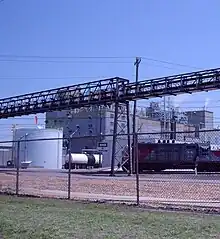
Chemical Industry in Italy refers to the set of businesses involved in the production and distribution of chemicals, both for industrial and consumer use within the country. This industry has been integral to Italy's economic development and modernization.
History
Italy's association with the chemical processes dates back to its ancient roots. The Romans, for instance, were known for their proficiency in various chemical processes, such as the production of dyes, glass, and certain metals.[1]
However, the origins of a structured chemical industry in Italy can be pinpointed to the late 19th century. As the European continent experienced an industrial boom, Italy too embarked on its path of industrialization, leading to a surge in the need for chemicals in various sectors like textiles, automotive, and construction.[2] The 20th century saw significant growth with the rise of numerous chemical companies, capitalizing on Italy's strategic location in Europe, its access to the Mediterranean, and its growing domestic market.[3]
World Wars greatly influenced the trajectory of the chemical industry. During World War I, there was a surge in the demand for chemicals for explosives, medicines, and other wartime essentials. Following World War II, the Marshall Plan provided a boost to Italy's reconstruction efforts, and the chemical industry played a pivotal role in rebuilding the country's infrastructure and economy.[4]

The latter half of the 20th century saw a shift towards more specialized and high-value chemicals, with a decline in the production of basic chemicals. This period also marked the rise of the pharmaceutical sector within the chemical industry, making Italy one of the prominent players in the European pharmaceutical market.[5][6]
Key sectors
Petrochemicals
Italy boasts a mature petrochemical sector, producing a variety of products such as plastics, synthetic rubber, and organic chemicals.[7]
Pharmaceuticals
The pharmaceutical sector in Italy is one of the country's most research-intensive industries, with strong global connections and a history of significant contributions.[8]
Agrochemicals
With a strong agricultural base, the production of fertilizers, pesticides, and other agrochemicals is another major sector.[9][10]
Specialty Chemicals
Italy has a niche in producing specialty chemicals used in cosmetics, food processing, and other industries.[11][12]
See also
References
- ↑ Oleson, John Peter (2014). Building for eternity: the history and technology of Roman concrete engineering in the sea. Oxford (GB): Oxbow Books. ISBN 978-1-78297-420-8.
- ↑ Blim, Michael L. (1990). Made in Italy: Small-Scale Industrialization and Its Consequences. Praeger. ISBN 978-0274639748.
- ↑ Fenoaltea, Stefano, ed. (2013). The reinterpretation of Italian economic history: from unification to the Great War (1st ed.). Cambridge: Cambridge University Press. ISBN 978-0-521-19238-5.
- ↑ MacLeod, Roy M.; Johnson, Jeffrey Allan (2006). Frontline and factory: comparative perspectives on the chemical industry at war, 1914-1924. Archimedes. Dordrecht: Springer. ISBN 978-1-4020-5489-1.
- ↑ Lesch, John E., ed. (2000). The German chemical industry in the twentieth century [...Conference on the German Chemical Industry in the Twentieth Century ... on March 20-22, 1997, at the University of California, Berkeley...] Chemists and chemistry. Dordrecht: Kluwer Academic Publishers. ISBN 978-0-7923-6487-0.
- ↑ Aftalion, Fred; Aftalion, Fred (1991). A history of the international chemical industry. The chemical sciences in society series (2. casebound pr ed.). Philadelphia: Univ. of Pennsylvania Press. ISBN 978-0-8122-1297-6.
- ↑ Galambos, Louis, ed. (2013). The global chemical industry in the age of the petrochemical revolution. Comparative perspectives in business history (1st ed.). Cambridge: Cambridge Univ. Press. ISBN 978-1-107-63054-3.
- ↑ W. Light, Donald; F. Maturo, Antonio (2015). Good Pharma. Palgrave Macmillan. ISBN 978-1137388339.
- ↑ Agrochemicals: Fate in Food and the Environment (PDF). International Atomic Energy Agency. 1982. ISBN 92-0-010382-0.
- ↑ Lamberth, Clemens; Dinges, Jürgen, eds. (2012). Bioactive heterocyclic compound classes. Weinheim: Wiley-VCH. ISBN 978-3-527-32993-9.
- ↑ Global Chemicals Market (by Category & Region): Insights & Forecast with Potential Impact of COVID-19 (2023-2027). Koncept Analytics. 2023.
- ↑ Thomson, Tim (2005). Polyurethanes as specialty chemicals: principles and applications. Boca Raton, Fla: CRC Press. ISBN 978-0-8493-1857-3.